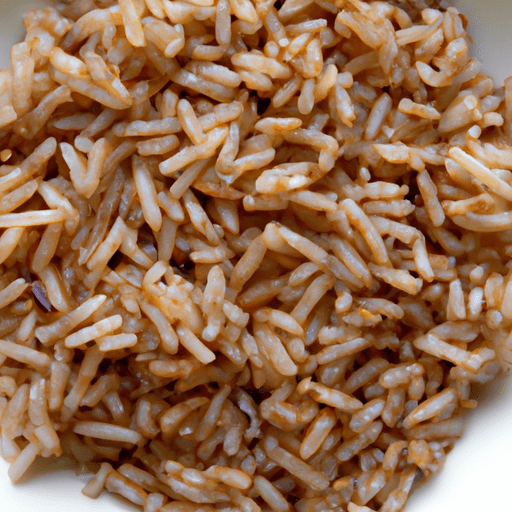The Wonderful World of Cooked Short-Grained Brown Rice
If you’re a fan of hearty and nutritious grains, then cooked short-grained brown rice should be at the top of your list. With its distinct earthy flavor and versatile nature, this culinary gem has captured the hearts and taste buds of people across the globe. In this blog post, we will embark on a culinary exploration of cooked short-grained brown rice, delving into its taste, common uses, nutritional value, and uncovering some interesting history and facts about this grain.
The Taste of Cooked Short-Grained Brown Rice
Short-grained brown rice boasts a rich, nutty flavor that sets it apart from its white rice counterpart. During the cooking process, the grain retains its bran and germ, resulting in a slightly chewy texture that delivers a delightful mouthfeel. This hearty taste pairs beautifully with a wide array of dishes, making it a favorite choice for many rice enthusiasts.
Common Uses in Cooking
Due to its robust flavor and slightly sticky texture, cooked short-grained brown rice is a versatile staple in various culinary cultures. It’s often featured in Asian cuisines, seamlessly complementing stir-fries, sushi rolls, and rice porridge. Additionally, it serves as a fantastic accompaniment for hearty stews, grain bowls, and vegetarian dishes. Whether you’re craving a comforting bowl of rice or seeking an addition to your favorite main course, cooked short-grained brown rice is a reliable and delicious choice.
Nutritional Value of Cooked Short-Grained Brown Rice
Beyond its delectable taste, cooked short-grained brown rice packs a powerful nutritional punch. It’s a fantastic source of complex carbohydrates and provides sustained energy. This grain is naturally high in dietary fiber, promoting digestive health and contributing to a feeling of fullness. Cooked short-grained brown rice is also abundant in minerals such as manganese, magnesium, and selenium, which play vital roles in supporting various bodily functions. Furthermore, unlike its refined white rice counterpart, brown rice retains its bran and germ, making it a valuable source of essential vitamins and antioxidants. This nutritional prowess makes cooked short-grained brown rice an excellent option for those seeking a wholesome and nourishing addition to their meals.
Unveiling the History and Facts
Did you know that cooked short-grained brown rice has been consumed for thousands of years? Originating in Southeast Asia, this grain has played a significant role in the culinary traditions of many cultures. Historically, it has been a staple food in regions such as Japan, Korea, and China, where it forms a fundamental part of the daily diet. As time progressed, cooked short-grained brown rice gained popularity worldwide due to its nutritional benefits and remarkable taste. Today, it continues to thrive as an essential ingredient in a wide range of global cuisines.
Cooked short-grained brown rice is truly a mouthwatering grain that has captured the hearts of food enthusiasts worldwide. Its distinct taste, versatility in cooking, impressive nutritional value, and rich history make it a must-have ingredient in any pantry. So why not elevate your culinary adventures by incorporating this delightful grain into your next meal? Whether you’re a seasoned foodie or an aspiring home cook, cooked short-grained brown rice is sure to bring a wholesome and delicious touch to your dining table.
Short Grained Brown Rice
Origin: Brown rice is a whole grain rice that has had only the husk removed, leaving the bran layer and germ intact. The exact origins of rice cultivation are unknown, but it is believed to have been domesticated in China around 10,000 years ago. Brown rice is thought to have been consumed for centuries, particularly in regions of Asia where rice cultivation is prevalent.
Common Uses: Cooked short grained brown rice is a versatile ingredient used in various dishes around the world. It is commonly used as a side dish, served alongside proteins like fish, chicken, or tofu. In Asian cuisines, it is frequently used in sushi, rice bowls, and rice porridge. Brown rice can also be used in salads, stir-fries, and even desserts.
Nutritional Benefits: Brown rice is considered more nutritious than polished white rice because it retains the bran layer and germ, which contain most of the fiber, vitamins, and minerals. It is a good source of complex carbohydrates, providing energy and dietary fiber. Brown rice also contains essential minerals like manganese, magnesium, and selenium, as well as B vitamins. It has a lower glycemic index compared to white rice, meaning it causes a slower rise in blood sugar levels.
Unique Properties: Short grained brown rice has a slightly chewy texture and a nutty flavor. Due to the presence of the bran layer, it requires a longer cooking time and more water than white rice. Brown rice can absorb flavors well, making it suitable for pairing with various seasonings and ingredients. It is also popular among individuals following gluten-free or vegan diets.
Historical Significance: Rice has played a significant role in the cultural and economic history of many societies. Ancient Chinese and Indian civilizations used rice as a staple crop, while in Japan, it became the basis of the country’s cuisine and a symbol of its agricultural heritage. In some cultures, rice holds cultural and spiritual importance, and its cultivation provided stability and economic growth in certain regions throughout history. Today, rice remains a staple food for millions of people worldwide, contributing to culinary traditions and livelihoods.




Use the share button below if you liked it.
It makes me smile, when I see it.